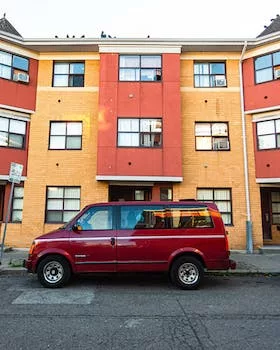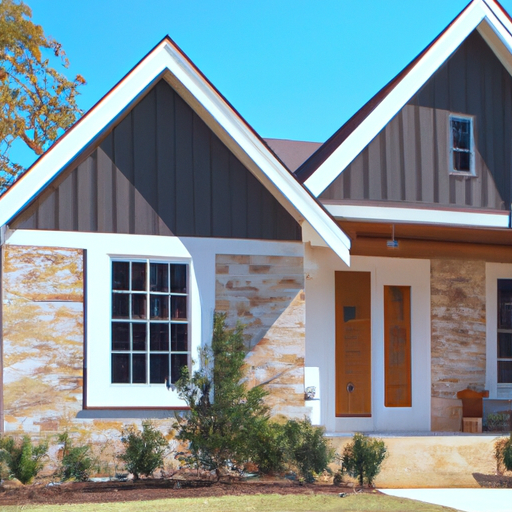Maximizing Curb Appeal: Architectural Elements that Transform Your Home’s Exterior
The role of architecture in enhancing your home’s curb appeal cannot be overstated. Curb appeal, the attractiveness of a property and its surroundings when viewed from the street, is a crucial factor in determining the value of a home. It is the first impression that potential buyers or visitors have of your property, and as the saying goes, you never get a second chance to make a first impression. In this regard, architectural elements play a significant role in transforming your home’s exterior and maximizing its curb appeal.
One of the most important architectural elements that can enhance your home’s curb appeal is the overall design and style of the house. A well-designed home with a cohesive and harmonious style will naturally be more appealing than a disjointed or poorly designed one. This includes the choice of materials, colors, and textures used in the construction of the house, as well as the layout and arrangement of windows, doors, and other exterior features. A home that is designed with a clear architectural style in mind, whether it be traditional, modern, or something in between, will have a strong visual impact and create a lasting impression on those who see it.
Another key architectural element that can greatly impact curb appeal is the roof. The roof is one of the most visible parts of a home’s exterior, and its design, color, and materials can significantly affect the overall appearance of the house. A well-maintained roof with clean lines and high-quality materials will not only protect your home from the elements but also add to its visual appeal. Additionally, the choice of roofing materials can also contribute to the energy efficiency of your home, which is an increasingly important consideration for many homeowners and potential buyers.
The entrance to your home is another crucial architectural element that can greatly influence curb appeal. A welcoming and inviting entryway, complete with a well-designed door, porch, and landscaping, can make a strong statement and set the tone for the rest of the property. The choice of door style, color, and hardware, as well as the design of the porch or entryway, should complement the overall architectural style of the house and create a sense of cohesion and harmony.
Windows are another essential architectural feature that can have a significant impact on your home’s curb appeal. The size, shape, and placement of windows can greatly affect the overall appearance of a house, as well as its energy efficiency and natural light levels. Well-designed windows that are proportionate to the size of the house and appropriately placed can create a sense of balance and symmetry, while also allowing for ample natural light to enter the home.
Landscaping is another important aspect of maximizing curb appeal, and while it may not be an architectural element in the strictest sense, it is closely related to the overall design and appearance of a property. A well-maintained and thoughtfully designed landscape can greatly enhance the visual appeal of a home, providing a sense of harmony and unity between the built environment and the natural surroundings. This includes the choice of plants, trees, and shrubs, as well as the design of pathways, driveways, and other hardscape elements.
In conclusion, the role of architecture in enhancing your home’s curb appeal is multifaceted and encompasses a wide range of elements, from the overall design and style of the house to the specific features such as the roof, entrance, windows, and landscaping. By carefully considering these elements and ensuring that they work together in a cohesive and harmonious manner, you can significantly improve the appearance of your home’s exterior and maximize its curb appeal, ultimately increasing its value and making it more attractive to potential buyers and visitors alike.
The Art of First Impressions: How Architectural Design Influences Home Curb Appeal

The role of architecture in enhancing your home’s curb appeal cannot be overstated. As the saying goes, “you never get a second chance to make a first impression.” This adage holds true not only for personal interactions but also for the appearance of your home. The architectural design of your home plays a significant role in creating that all-important first impression, which can have a lasting impact on how others perceive your property. In this article, we will explore the various ways in which architectural design influences home curb appeal and how you can leverage these principles to create a visually stunning and inviting exterior.
One of the most critical aspects of architectural design that affects curb appeal is the overall style and aesthetic of your home. The architectural style should be consistent and harmonious with the surrounding neighborhood, as well as your personal preferences and tastes. A home that stands out as an eyesore or is mismatched with its surroundings can detract from its curb appeal, while a home that blends seamlessly with the neighborhood and showcases a unique yet tasteful design will undoubtedly draw admiration and interest.
Another essential factor in architectural design is the use of materials and textures. The choice of materials for your home’s exterior can significantly impact its curb appeal, as different materials evoke different feelings and associations. For example, a home with a brick exterior may convey a sense of warmth and tradition, while a sleek, modern design with glass and steel elements may evoke a sense of sophistication and cutting-edge style. The key is to select materials that not only complement the architectural style of your home but also enhance its overall appearance and appeal.
The layout and organization of your home’s exterior spaces also play a crucial role in determining its curb appeal. A well-designed landscape can significantly enhance the visual appeal of your property, while a poorly planned or cluttered exterior can detract from its attractiveness. Consider incorporating elements such as walkways, patios, and gardens that not only add visual interest but also create a sense of flow and connectivity between your home and its surroundings. Additionally, pay attention to the placement and design of exterior lighting, as this can greatly impact the overall ambiance and appeal of your home during nighttime hours.
The architectural design of your home’s entryway is another critical aspect of curb appeal. A welcoming and inviting entryway can set the tone for the rest of your home and create a positive first impression for visitors. Consider incorporating design elements such as a bold front door, attractive lighting, and eye-catching landscaping to create a memorable and appealing entrance to your home.
Lastly, it is essential to consider the impact of architectural details and accents on your home’s curb appeal. Elements such as window trim, shutters, and decorative molding can add character and charm to your home’s exterior, while also serving to highlight and accentuate its architectural style. Be mindful of the scale and proportion of these details, as well as their placement and arrangement, to ensure that they enhance rather than detract from your home’s overall appearance.
In conclusion, the role of architecture in enhancing your home’s curb appeal is multifaceted and complex. By carefully considering the various aspects of architectural design, such as style, materials, layout, entryway design, and architectural details, you can create a visually stunning and inviting exterior that leaves a lasting impression on all who pass by. Remember that a well-designed home not only increases its curb appeal but also contributes to the overall aesthetic and character of your neighborhood, making it a more enjoyable and desirable place to live.
Timeless Architectural Styles: Boosting Your Home’s Curb Appeal with Classic Design Choices
The role of architecture in enhancing your home’s curb appeal cannot be overstated. A well-designed home not only adds value to your property but also creates a lasting impression on visitors and passersby. Timeless architectural styles have a unique ability to boost your home’s curb appeal with classic design choices that never go out of style. In this article, we will explore some of these enduring architectural styles and how they can elevate the aesthetic appeal of your home.
One of the most iconic and timeless architectural styles is the Georgian style, which originated in England during the 18th century. This style is characterized by its symmetry, balance, and proportion, with a focus on classical elements such as columns, pediments, and cornices. Georgian homes often feature brick or stone exteriors, multi-pane windows, and a central entrance with a decorative crown or pediment. Incorporating these elements into your home’s design can create a sense of elegance and sophistication that is sure to impress.
Another classic architectural style that can enhance your home’s curb appeal is the Victorian style. This style emerged during the reign of Queen Victoria in the 19th century and is known for its ornate details, asymmetrical facades, and elaborate trim work. Victorian homes often feature steeply pitched roofs, decorative gables, and intricate woodwork, such as gingerbread trim and turned porch posts. By incorporating these design elements into your home, you can create a sense of grandeur and opulence that is sure to make your property stand out.
The Craftsman style, which originated in the early 20th century, is another timeless architectural style that can boost your home’s curb appeal. This style is characterized by its emphasis on natural materials, such as wood and stone, as well as its simple, functional design. Craftsman homes often feature low-pitched roofs with wide eaves, exposed rafters, and decorative brackets or corbels. The use of natural materials and handcrafted details in a Craftsman home can create a warm, inviting atmosphere that is both visually appealing and comfortable to live in.
The Mediterranean style, which draws inspiration from the architecture of countries such as Spain, Italy, and Greece, is another classic design choice that can enhance your home’s curb appeal. This style is characterized by its use of stucco or plaster exteriors, red tile roofs, and arched windows and doorways. Mediterranean homes often feature courtyards, balconies, and terraces, which create a seamless connection between indoor and outdoor living spaces. By incorporating these design elements into your home, you can create a sense of luxury and sophistication that is reminiscent of a Mediterranean villa.
Finally, the Colonial style, which originated in the United States during the 17th century, is another timeless architectural style that can boost your home’s curb appeal. This style is characterized by its symmetrical facades, multi-pane windows, and central entrances with decorative crowns or pediments. Colonial homes often feature brick or wood exteriors, steeply pitched roofs, and prominent chimneys. Incorporating these design elements into your home can create a sense of history and tradition that is sure to impress.
In conclusion, timeless architectural styles have the unique ability to enhance your home’s curb appeal with classic design choices that never go out of style. By incorporating elements from styles such as Georgian, Victorian, Craftsman, Mediterranean, and Colonial into your home’s design, you can create a visually appealing and enduring property that is sure to leave a lasting impression. Whether you are building a new home or renovating an existing one, considering these classic architectural styles can help you create a beautiful and timeless property that will stand the test of time.
Q&A
Question 1: How does architectural style influence a home’s curb appeal?
Answer 1: Architectural style plays a significant role in a home’s curb appeal by creating a visually appealing and harmonious exterior. The style sets the tone for the overall aesthetic, incorporating elements such as rooflines, window shapes, and materials that complement each other and create a cohesive look. A well-executed architectural style can make a home stand out and increase its attractiveness to potential buyers.
Question 2: What architectural elements can be used to enhance a home’s curb appeal?
Answer 2: Several architectural elements can be used to enhance a home’s curb appeal, including the choice of materials, colors, and textures, as well as the design of doors, windows, and landscaping. Other elements include the use of decorative details such as shutters, trim, and molding, as well as the integration of outdoor lighting and hardscaping features like walkways and driveways.
Question 3: How can landscaping and outdoor spaces contribute to a home’s curb appeal?
Answer 3: Landscaping and outdoor spaces contribute to a home’s curb appeal by creating an inviting and well-maintained appearance. Thoughtful landscaping can highlight the architectural features of a home, provide a sense of privacy, and create a visually appealing environment. Outdoor spaces such as patios, decks, and porches can also enhance curb appeal by extending the living area and providing additional areas for relaxation and entertainment.
Conclusion
In conclusion, architecture plays a crucial role in enhancing a home’s curb appeal by incorporating visually appealing design elements, creating a harmonious balance with the surrounding environment, and reflecting the homeowner’s personal style. A well-designed home not only increases its value but also contributes to the overall aesthetic of the neighborhood.


